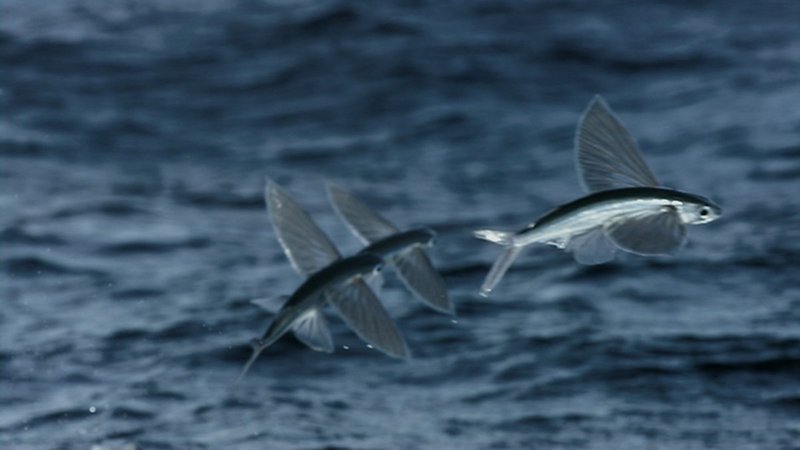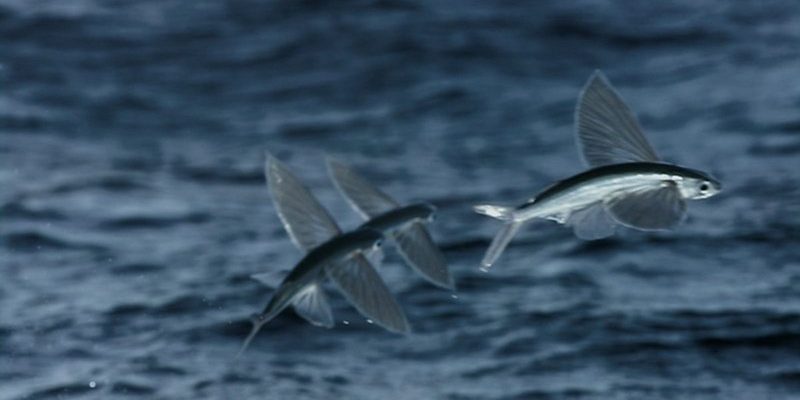
When you think about fish, you probably picture them swimming gracefully through water, right? Now, imagine a fish that can leap from the ocean’s surface and glide through the air! This is the amazing reality of flying fish. They don’t just jump; they soar, using special adaptations that allow them to glide over the water for impressive distances. These incredible creatures can cover more than 200 meters in a single flight. Imagine a fish taking to the skies, like a bird, dodging predators and searching for a safe place to land!
Physical Characteristics of Flying Fish
Flying fish belong to the family Exocoetidae, and they have unique features that help them take flight. These fish have elongated bodies and large, wing-like fins that enable them to glide. Their pelvic fins are also large and help provide the stability they need when soaring through the air. A typical flying fish can grow up to 12 inches long, although some species can reach lengths of up to 18 inches!
Their coloration adds to their appeal. Most flying fish have a blue or greenish back, which makes them difficult to spot against the ocean’s surface. Their undersides are typically silvery, which helps them camouflage against predators lurking below. So, next time you see a glimpse of something sparkling in the water, it might just be a flying fish preparing for takeoff!
How Do Flying Fish Glide?
You might be thinking: how do these fish even manage to take off and glide? Well, flying fish use their speed and the surface tension of the water to achieve flight. When threatened by predators, they can swim rapidly toward the surface of the water. Just before they breach the surface, they angle their bodies upward and leap out of the water. Their remarkable fins unfold, allowing them to glide gracefully through the air.
During these glides, flying fish can bank and turn, almost like an acrobat in the air. They rely on the wind and the ocean currents to carry them, sometimes flying for 30 seconds or more. This fascinating strategy not only helps them escape predators, but it also gives them a chance to find food and new habitats while keeping an eye on their surroundings.
Habitat and Distribution
Flying fish are found mostly in warm, tropical, and subtropical oceans around the world. They prefer the open seas, especially in areas where there are plenty of plankton and small fish to eat. You can often spot them in the Atlantic, Pacific, and Indian Oceans, as well as in the Caribbean Sea. They enjoy habitats that are close to the surface of the water, making it easier for them to leap and glide.
Interestingly, flying fish tend to gather in schools. These schools can range from just a few individuals to hundreds of fish. Being in a group helps protect them from predators, as there’s safety in numbers. When one fish jumps, the others often follow, creating a stunning display of gliding fish moving as one entity.
Diet and Feeding Habits
So, what do these aerial acrobats munch on? Primarily, flying fish are plankton eaters. They feed on tiny creatures like copepods and small shrimp, which they find near the ocean surface. When they’re hungry, they glide and hunt for food, using their speed and agility to swoop down, catch their prey, and then leap back into the air.
Flying fish have a unique feeding technique. They skim along the surface, just below the water, snapping up small bits of food as they go. This strategy not only allows them to eat efficiently but also reduces the risk of being spotted by larger fish that might want to snack on them. It’s a clever way of dining, don’t you think?
Reproduction and Lifespan
Flying fish have a fascinating reproductive cycle. They typically spawn in warmer waters during the summer months. Female flying fish can lay thousands of eggs, which float on the ocean’s surface to keep them safe from predators. These eggs hatch quickly, usually within a week or two, giving rise to tiny, free-swimming fry that will grow into adults.
As for lifespan, flying fish can live up to 4-5 years in the wild. Their short lives are often spent leaping through waves, dodging predators, and exploring the sunlit waters where they thrive. While they may not have the longest lifespans, their unique adaptations and behaviors make them some of the most fascinating fish in the ocean.
Flying Fish in Culture and Mythology
Human fascination with flying fish goes back centuries. In various cultures, these remarkable creatures have been seen as symbols of freedom and agility. Some coastal communities consider flying fish a delicacy, incorporating them into local cuisine. Imagine sitting down to a meal that includes fish that can fly; it’s definitely a conversation starter!
Additionally, flying fish have made appearances in folklore. In some Polynesian myths, they’re depicted as messengers of the sea, delivering tidings from the depths to the skies above. Their ability to glide is often linked to spiritual themes, representing the connection between different worlds. So, flying fish aren’t just extraordinary in nature; they carry cultural significance as well.
Conservation Status
While flying fish are not currently classified as endangered, they face challenges due to overfishing and habitat degradation. Climate change also affects their habitats, altering ocean temperatures and currents that could impact their populations. Sustainable fishing practices and protective measures are crucial to ensure that flying fish continue to thrive in their habitats.
Research and awareness about these fishes are essential, especially as we learn more about ocean health. By understanding the ecology of our oceans and the role flying fish play in it, we can take steps to protect these remarkable creatures and their ecosystems.
| Characteristic | Details |
| Size | Up to 12 inches, some species up to 18 inches |
| Habitat | Warm, tropical, and subtropical oceans |
| Diet | Plankton, small fish, and crustaceans |
| Speed | Can reach speeds of up to 37 mph when leaping |
| Lifespan | About 4-5 years |
FAQ
Can flying fish actually fly?
While flying fish don’t fly in the same way birds do, they can glide over water for considerable distances. When they leap out of the water, their large fins help them stay in the air, making it look like they’re flying. They can cover impressive lengths, sometimes reaching over 200 meters in a single glide.
What predators do flying fish have?
Flying fish have to be wary of several predators, which include larger fish, seabirds, and even some marine mammals. Their ability to leap and glide helps them escape from these threats, allowing them to dodge potential danger and find safety in their aerial maneuvers.
Are all flying fish the same species?
No, there are about 70 different species of flying fish. While they share similar adaptations that allow them to glide, they vary in size, color, and specific habitats. Each species has unique traits that help them thrive in their respective environments.
How do flying fish contribute to ocean ecosystems?
Flying fish play a significant role in marine ecosystems. As both prey and predators, they help maintain the balance in their habitats. They feed on plankton, which helps regulate those populations, while also providing a food source for larger fish and other marine animals.
Can flying fish be found in freshwater?
No, flying fish are strictly saltwater species. They thrive in the ocean’s warm waters and have adapted to live in that specific environment. Freshwater fish have different adaptations and behaviors that don’t include gliding.
How fast can flying fish swim?
Flying fish can swim quite quickly, reaching speeds of up to 37 miles per hour when they make their leaps. This speed helps them evade predators and gain enough momentum for their impressive glides through the air.
Do flying fish migrate?
While flying fish don’t have long migration patterns like some other fish species, they can move to different areas based on food availability and environmental conditions. They may alter their location seasonally, especially during spawning periods when they seek warmer, shallower waters for reproduction.
How can I spot flying fish in the wild?
To see flying fish, you often need to be in warm, tropical waters. They are most active during the early morning and evening. Look closely at the ocean surface, especially if you see splashes or small groups of fish leaping out of the water. If you’re on a boat, keep your eyes peeled; you might just catch a glimpse of these magnificent gliders!

